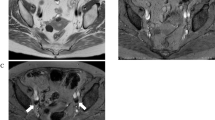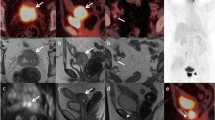Abstract
The aim of this study was to assess nodal enhancement with ultrasmall superparamagnetic iron oxide (USPIO)-enhanced magnetic resonance imaging (MRI) during preoperative staging of gynecological pelvic tumors within the same imaging session for the primary tumor. Pelvic MRI was performed 18–28 h after intravenous infusion of USPIO (Combidex/Sinerem, 2.6 mg Fe/kg body weight) in 13 women (mean age 51 years) scheduled for surgery for biopsy proven (n=11) or clinically suspected (n=2) uterine carcinoma. Axial T1-weighted spin-echo (SE), T2-weighted fast SE (FSE; with fat saturation), fast spoiled gradient-recalled (FSPGR) echo, sagittal and oblique T2-weighted FSE sequences were acquired on a 1.5-T system. Lymph nodes were prospectively staged using standard criteria, i.e., size and shape, as well as USPIO enhancement. Results were correlated with histology findings. MRI correctly staged all primary uterine tumors. In one case, the preoperative diagnosis of stage IV switched the therapeutic approach to radiochemotherapy. Ninety-one (86 benign, 5 malignant) of the histologically characterized nodes could be correlated with their MRI counterparts. One node was false positive; three micrometastases greater than 5 mm and one 5-mm metastasis were missed. On a nodal basis, the sensitivity score was 0.33 and the specificity score, 0.99. On a patient basis, the sensitivity score was 0.25 and the specificity score, 0.80. Our preliminary results indicate that USPIO-enhanced pelvic MRI for preoperative nodal assessment is feasible within one imaging session for primary tumors and that it has a high specificity. However, the low sensitivity in the present study is a limitation for the clinical application of this technique.





Similar content being viewed by others
References
Grigsby PW, Herzog TJ (2001) Current management of patients with invasive cervical carcinoma. Clin Obstet Gynecol 44:531–537
Boronow RC, Morrow CP, Creasman WT et al (1984) Surgical staging in endometrial cancer: clinical-pathologic findings of a prospective study. Obstet Gynecol 63:825–832
Lurain JR, Rice BL, Rademaker AW, Poggensee LE, Schink JC, Miller DS (1991) Prognostic factors associated with recurrence in clinical stage I adenocarcinoma of the endometrium. Obstet Gynecol 78:63–69
Sevin BU, Nadji M, Lampe B et al (1995) Prognostic factors of early stage cervical cancer treated by radical hysterectomy. Cancer 76:1978–1986
Buckley SL, Tritz DM, Van Le L et al (1996) Lymph node metastases and prognosis in patients with stage IA2 cervical cancer. Gynecol Oncol 63:4–9
Shepherd JH (1989) Revised FIGO staging for gynaecological cancer. Br J Obstet Gynaecol 96:889–892
UICC (2002) TNM Classification of Malignant Tumour. In: Sobin LH, Ch. Wittekind (eds), 6th edn
Subak LL, Hricak H, Powell CB, Azizi L, Stern JL (1995) Cervical carcinoma: computed tomography and magnetic resonance imaging for preoperative staging. Obstet Gynecol 86:43–50
Kinkel K, Kaji Y, Yu KK et al (1999) Radiologic staging in patients with endometrial cancer: a meta-analysis. Radiology 212:711–718
Roy C, Le Bras Y, Mangold L et al (1997) Small pelvic lymph node metastases: evaluation with MR imaging. Clin Radiol 52:437–440
Scheidler J, Hricak H, Yu KK, Subak L, Segal MR (1997) Radiological evaluation of lymph node metastases in patients with cervical cancer. A meta-analysis. JAMA 278:1096–1101
Bellin MF, Roy C, Kinkel K et al (1998) Lymph node metastases: safety and effectiveness of MR imaging with ultrasmall superparamagnetic iron oxide particles–initial clinical experience. Radiology 207:799–808
Kim SH, Kim SC, Choi BI, Han MC (1994) Uterine cervical carcinoma: evaluation of pelvic lymph node metastasis with MR imaging. Radiology 190:807–811
Weissleder R, Elizondo G, Wittenberg J, Lee AS, Josephson L, Brady TJ (1990) Ultrasmall superparamagnetic iron oxide: an intravenous contrast agent for assessing lymph nodes with MR imaging. Radiology 175:494–498
Rogers JM, Lewis J, Josephson L (1994) Visualization of superior mesenteric lymph nodes by the combined oral and intravenous administration of the ultrasmall superparamagnetic iron oxide, AMI-227. Magn Reson Imaging 12:1161–1165
Anzai Y, Blackwell KE, Hirschowitz SL et al (1994) Initial clinical experience with dextran-coated superparamagnetic iron oxide for detection of lymph node metastases in patients with head and neck cancer. Radiology 192:709–715
Hamm B (2002) Iron-oxide-enhanced MR lymphography: just a new toy or a breakthrough? Eur Radiol 12:957–958
Nguyen BC, Stanford W, Thompson BH et al (1999) Multicenter clinical trial of ultrasmall superparamagnetic iron oxide in the evaluation of mediastinal lymph nodes in patients with primary lung carcinoma. J Magn Reson Imaging 10:468–473
Pannu HK, Wang KP, Borman TL, Bluemke DA (2000) MR imaging of mediastinal lymph nodes: evaluation using a superparamagnetic contrast agent. J Magn Reson Imaging 12:899–904
Mack MG, Balzer JO, Straub R, Eichler K, Vogl TJ (2002) Superparamagnetic iron oxide-enhanced MR imaging of head and neck lymph nodes. Radiology 222:239–244
Stets C, Brandt S, Wallis F, Buchmann J, Gilbert FJ, Heywang-Kobrunner SH (2002) Axillary lymph node metastases: a statistical analysis of various parameters in MRI with USPIO. J Magn Reson Imaging 16:60–68
Michel SC, Keller TM, Frohlich JM et al (2002) Preoperative breast cancer staging: MR imaging of the axilla with ultrasmall superparamagnetic iron oxide enhancement. Radiology 225:527–536
Harisinghani MG, Saini S, Weissleder R et al (1999) MR lymphangiography using ultrasmall superparamagnetic iron oxide in patients with primary abdominal and pelvic malignancies: radiographic-pathologic correlation. Am J Roentgenol 172:1347–1351
Hricak H, Lacey CG, Sandles LG, Chang YC, Winkler ML, Stern JL (1988) Invasive cervical carcinoma: comparison of MR imaging and surgical findings. Radiology 166:623–631
Hricak H, Rubinstein LV, Gherman GM, Karstaedt N (1991) MR imaging evaluation of endometrial carcinoma: results of an NCI cooperative study. Radiology 179:829–832
Sironi S, Belloni C, Taccagni GL, DelMaschio A (1991) Carcinoma of the cervix: value of MR imaging in detecting parametrial involvement. Am J Roentgenol 156:753–756
Sironi S, Colombo E, Villa G et al (1992) Myometrial invasion by endometrial carcinoma: assessment with plain and gadolinium-enhanced MR imaging. Radiology 185:207–212
Wang YX, Hussain SM, Krestin GP (2001) Superparamagnetic iron oxide contrast agents: physicochemical characteristics and applications in MR imaging. Eur Radiol 11:2319–2331
Vassallo P, Matei C, Heston WD, McLachlan SJ, Koutcher JA, Castellino RA (1995) Characterization of reactive versus tumor-bearing lymph nodes with interstitial magnetic resonance lymphography in an animal model. Invest Radiol 30:706–711
Sigal R, Vogl T, Casselman J et al (2002) Lymph node metastases from head and neck squamous cell carcinoma: MR imaging with ultrasmall superparamagnetic iron oxide particles (Sinerem MR) – results of a phase-III multicenter clinical trial. Eur Radiol 12:1104–1113
Bellin MF, Beigelman C, Precetti-Morel S (2000) Iron oxide-enhanced MR lymphography: initial experience. Eur J Radiol 34:257–264
Tanoura T, Bernas M, Darkazanli A, et al (1992) MR lymphography with iron oxide compound AMI-227: studies in ferrets with filariasis. Am J Roentgenol 159:875–881
Acknowledgments
The study was partly supported by a grant from the Frau Henriette Rossiez-Treichler Legacy, Zurich, Switzerland.
Author information
Authors and Affiliations
Corresponding author
Rights and permissions
About this article
Cite this article
Keller, T.M., Michel, S.C.A., Fröhlich, J. et al. USPIO-enhanced MRI for preoperative staging of gynecological pelvic tumors: preliminary results. Eur Radiol 14, 937–944 (2004). https://doi.org/10.1007/s00330-004-2258-8
Received:
Revised:
Accepted:
Published:
Issue Date:
DOI: https://doi.org/10.1007/s00330-004-2258-8




